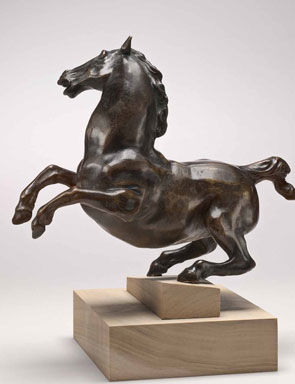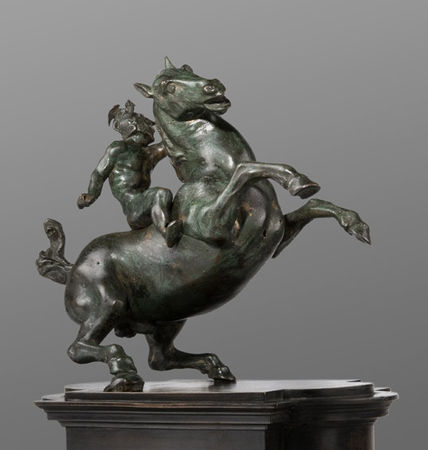'The Budapest Horse: A Leonardo da Vinci Puzzle' @ the National Gallery of Art
After Leonardo da Vinci (?), Italian (Italian, 1452 - 1519), Rearing Horse, possibly 19th century, copper-zinc alloy (brass), overall: H 21.6 x W 13.9 x L 26.7 cm (H 8 1/2 x W 5 1/2 x L 10 1/2 in.) Lent by The Metropolitan Museum of Art, Rogers Fund, 1925 (25.74)
WASHINGTON, DC.- The Rearing Horse and Mounted Warrior, a bronze statuette from the Museum of Fine Arts (Szépművészeti Múzeum), Budapest, is the focus of recent technical examinations by National Gallery of Art conservators and is also the centerpiece of a small exhibition, The Budapest Horse: A Leonardo da Vinci Puzzle. On view from July 3 through September 7, 2009, in the Gallery's West Building Sculpture Galleries, the intriguing work is joined by two additional bronze horses and two warriors associated with Leonardo da Vinci from international collections, along with two Renaissance bronze horses by known masters for comparison. Illustrative panels present evidence related to the works' origins, including reproductions of drawings by Leonardo, x-radiographs, and computer models.
The similarities of the Budapest horse to Leonardo's drawings led to the first attribution to him in 1916. New technical evidence gathered from both the Rearing Horse and its accompanying Mounted Rider suggests that the cast could date from as early as the 16th century, although possibly some years after Leonardo's death in 1519. No scientific data were discovered that rule out an early casting date, but the origins of the clay or wax models from which the horse and its rider were cast remain a mystery.
"At the request of the Museum of Fine Arts in Budapest, the National Gallery of Art is pleased to include the study of the Budapest horse's origins in its ongoing Renaissance Bronze Research Project," said Earl A. Powell III, director, National Gallery of Art. "We are grateful to Robert H. Smith and to the government of Hungary for making possible this rare opportunity to study and exhibit these bronzes together."
"The exhibition reflects an extraordinary moment of cross-cultural collaboration and new scholarship and a fabled Italian sculpture from a renowned Hungarian collection is now on view in one of America's finest museums," said László Jakab Orsós, the director of the Hungarian Cultural Center, New York. "We are so pleased to include the Budapest Horse as part of the Extremely Hungary festival."
Background
Around 1820, Hungarian sculptor István Ferenczy assembled a collection of sculpture in Rome, including a small bronze horse and rider that was acquired by the Museum of Fine Arts, Budapest, in 1914. Two years later, museum curator Simon Meller published arguments that this statuette, once prized as an ancient Greek work, was in fact a Renaissance bronze, cast from figures modeled in clay or wax by Leonardo da Vinci (1452–1519).
The case for Leonardo, though widely debated, has been taken more seriously than most attributions of sculpture to him. As part of the ongoing Renaissance Bronze Research Project at the National Gallery of Art, and at the request of the Museum of Fine Arts, Budapest, conservators undertook a technical study to investigate the materials and methods of fabricating the Budapest bronze sculpture. Procedures employed included x-radiography, alloy analysis by x-ray fluorescence spectroscopy, and three-dimensional laser scanning. The initial results, involving comparison with similar studies of other bronzes, contribute new material for the discussion of the question considered in this exhibition: do the Budapest horse and rider simply record inspiration from Leonardo's designs, or could they preserve the forms of a work from his hands?
Leonardo, Sculpture, and Horses
While there is no extant undisputed sculpture by Leonardo, evidence that he made sculpture is extensive. Giorgio Vasari, the Florentine painter and biographer of artists, reported in 1568 that Leonardo had modeled clay heads of laughing women and children; he also referred to a small wax horse by Leonardo, lost by Vasari's time but "held to be perfect." In at least one case Leonardo wrote himself a reminder to make a small wax version of one of his drawings.
Leonardo made ambitious and well-known attempts to produce two bronze equestrian statues for the city of Milan, each initially designed with the horse rearing: the monuments to Duke Francesco Sforza (in progress, 1483–1493) and to the general Gian Giacomo Trivulzio (in progress, 1508–1512); however, neither of these challenging works was ever cast in bronze.
Other Renaissance writers, including the MiIanese artist Giovanni Paolo Lomazzo and Florentine sculptor Benvenuto Cellini, mention small sculptural models made by Leonardo or used to work out compositions for painting. Lomazzo referred to a horse modeled of plastica (clay or wax) by Leonardo that belonged to the sculptor Leone Leoni. Rearing and twisting horses occur often in Leonardo's work as incarnations of spiraling energy, which the artist loved to make visible in depictions of curling hair and swirling water. Leonardo's drawings, full of movements echoed in the distinctive pose of the Budapest horse, are the main evidence cited to attribute the bronze to him.
Cast from models attributed to Leonardo da Vinci, Rearing Horse and Mounted Warrior, 16th century or later, copper-tin alloy with lead (bronze) overall: H 24 x W 15 x L 28 cm (H 9 7/16 x W 5 7/8 x L 11 in.) Szépművészeti Múzeum (Museum of Fine Arts), Budapest
The Questions and Findings
X-radiography indicates that all of the sculptures examined for this study were cast using the lost-wax technique, a typical method for producing small bronze sculptures, practiced since antiquity and refined during the Renaissance.
The Budapest horse is to all evidence a unique cast; its alloy and casting technique, although unusual in certain respects, show no inconsistencies with Renaissance practice, though they do also occur later. The greenish patina, exceptional for a Renaissance bronze, could result from a later treatment to make the bronze look ancient, as the 19th-century owner considered it.
The bronze reveals minimal attention to finish either in the model or the cast. Core-pin holes, casting flaws, and even the opening cut out around the tail for core removal were not repaired with metal fills. Only minimal tooling of details was done after casting. These features suggest more interest in preserving the form of a valued model made of fragile material, either clay or wax, than in creating a refined collector's bronze.
Although their consistent bronze alloys indicate the Budapest horse and rider were cast at the same time, the horse's design makes little provision for a rider. There is no saddle or attachment mechanism (the present pin and the hole drilled in the horse's back to accommodate it are modern), and the smaller scale of the rider makes a questionable fit for the horse. These factors raise the possibility that the model for the rider was provided later by a different artist to lend narrative interest to a preexisting horse. To invite consideration of this possibility, the National Gallery of Art will display the horse and rider separately for the first time.
Rearing Horse, lent from The Metropolitan Museum of Art, and first recorded in 1925, seems to be based on the Budapest horse. A three-dimensional comparison of the two horses indicated that the wax model for the New York horse was probably cast in molds taken from the Budapest bronze, with some alterations to the pose and details. While copper alloys comparable to the high-zinc composition of the New York horse can be found in some Renaissance sculptures, its thin metal walls and the high-melting solder used in its fabrication point to technologies available only since the 19th century.
A smaller bronze Rearing Horse from The Hunt Museum in Limerick, Ireland, first documented in 1966, conforms more closely to the Budapest horse in some aspects of the form, but differs in alloy and facture from the other horses and appears to come from a different workshop than either the Budapest or New York versions. Alloy analysis revealed an absence of typical Renaissance trace elements, such as silver, suggesting that the Limerick horse may have been cast following the late 19th-century introduction of electrolytic refining of metals.
The Cowering Warrior from the Poldi Pezzoli Museum in Milan, inventoried in 1816 in an old Milanese collection, corresponds closely to a small figure in an engraving made in c. 1500 that records four of Leonardo's designs of 1483/1493 for an equestrian monument planned for Milan. Its alloy composition is not typical for Italian Renaissance sculpture, but has been more commonly observed in northern European casts from the same period. With its assured but simplified anatomy and expressive face, the diminutive, solid-cast warrior could exemplify direct casting of small wax models produced in Leonardo's workshop based on his designs.
For broader comparison, the exhibition includes examples of leaping and rearing bronze stallions from the Robert H. Smith Collection, promised gifts to the National Gallery of Art. One is by a northern Italian sculptor from Leonardo's lifetime, Severo da Ravenna (documented 1496–1525). Another, by the Florentine master Antonio Susini (1558–1624), dates from a century later. These elegantly realized works, made for collectors, testify to the Renaissance fascination with the problem that captivated Leonardo: the rearing horse as an embodiment of power, energy, and its challenging stance. At the same time, their more refined execution contrasts with the apparently experimental character of the forms, movement, and minimal finish of the Budapest horse.
Curator and Conservators
Research for this project and exhibition was carried out by Shelley Sturman, head of object conservation; Katherine May, associate object conservator; and Alison Luchs, curator of early European sculpture.
Cast from model by or after Leonardo da Vinci, Italian (Italian, 1452 - 1519) Rearing Horse, 16th century or later, copper-tin alloy with lead (bronze) overall: H 24 x W 15 x L 28 cm (H 9 7/16 x W 5 7/8 x L 11 in.) Szépmüvészeti Múzeum (Museum of Fine Arts), Budapest.

/https%3A%2F%2Fprofilepics.canalblog.com%2Fprofilepics%2F1%2F0%2F100183.jpg)
/https%3A%2F%2Fstorage.canalblog.com%2F03%2F02%2F119589%2F96711876_o.jpg)
/https%3A%2F%2Fstorage.canalblog.com%2F11%2F31%2F119589%2F94773502_o.jpg)
/https%3A%2F%2Fstorage.canalblog.com%2F20%2F83%2F119589%2F94772815_o.jpg)
/https%3A%2F%2Fstorage.canalblog.com%2F26%2F72%2F119589%2F75604929_o.jpg)
/https%3A%2F%2Fstorage.canalblog.com%2F59%2F60%2F119589%2F26458628_o.jpg)





/image%2F1371349%2F20240406%2Fob_b23648_434058570-1644317966338216-88086167391.jpg)
/image%2F1371349%2F20240403%2Fob_6d5ae7_dp-28103-001.jpg)
/image%2F1371349%2F20240229%2Fob_8f31f9_431013694-1625286614908018-33034430839.jpg)
/http%3A%2F%2Fstorage.canalblog.com%2F79%2F20%2F119589%2F129837997_o.jpg)